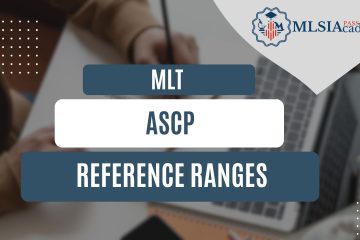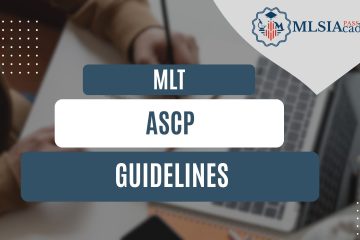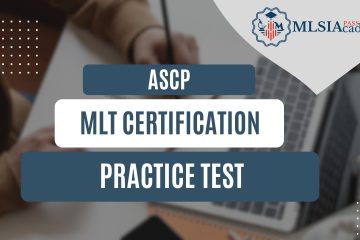ASCP MLT Outlines: What is the Exam Syllabus?
To pass the ASCP MLT exam with great scores, you must cover the syllabus with all ASCP MLT outlines.
The ASCP BOC offers complete details about the syllabus in the “Content Guideline”
The board explained the following information regarding the exam content areas
- 7 subjects with outlines
- Question percentage for each subject
- Calculations
- Reference ranges
This blog post will illustrate the ASCP MLT outlines with all exam content areas.
ASCP MLT Outlines: Detailed Information
The American Society for Clinical Pathology Board of Certification always works for professional comfort.
Therefore, it explains all processes with detailed information for its all ASCP certification including MLT.
The following table shows all subjects with question percentages:
| Content Area | Exam Question Percentage |
| Blood Bank | 15-20% |
| Chemistry | 20-25% |
| Urine and Other Body Fluids | 5-10% |
| Hematology | 20-25% |
| Microbiology | 15-20% |
| Immunology | 5-10% |
| Laboratory Operation | 5-10% |
ASCP MLT Outlines: For Each Subject
ASCP MLT Outlines: For Blood Banking
Blood product
- Donor
- Processing
- Storage
- Blood components
- Blood component quality control
Blood Group Systems
- Genetics
- Biochemistry/Antigens
- Role of blood groups in the transfusion process
Blood Group Immunology
- Immune response
- Immunoglobulins
- Antigen-antibody interactions
- Complement
Physiology and Pathophysiology
- Physical of blood
- Hemostasis & coagulation
- Hemolytic disorder of newborn and fetus
- Transplantation
- Anemias
Molecular and Serologic Testing
- Routine tests
- Reagents
- Application of special reagents and tests
- Platelet and Leukocytes testing
- Quality assurance
Transfusion Practice
- Component therapy
- Transfusions indications
- Transfusion (adverse effects)
- Extracorporeal circulation
- Apheresis circulation
- Patient blood management
- Blood administration
ASCP MLT Outlines: For Urine and Body Fluids
Urinalysis
- Physical
- Disease states
- Renal physiology
- Chemical
- Microscopic
Body Fluids (Semen, Synovial, CSF, Feces, Serous, etc.)
- Microscopic
- Disease conditions
- Chemical
- Physiology
- Physical
ASCP MLT Outlines: For Chemistry
General Chemistry
- Carbohydrates
- Lipids
- Heme derivatives
Proteins and Enzymes
- Enzymes
- Nitrogen-containing compounds including proteins
Electrolytes & Blood Gases and Acid-Base
- Determinations of acid-base
- Electrolytes
Special Chemistry
- Endocrinology
- Nutrition and vitamins
- Toxicology
- Therapeutic drug detecting
ASCP MLT Outlines: For Hematology
Hematology Physiology
- Function
- Destruction
- Production
Hematology Disease Conditions
- Erythrocytes
- Platelets
- Leukocytes
Hematology lab Testing
- Cell counts (for all body fluids including blood)
- Morphology evaluation and differentials (for all body fluids)
- Indices
- Hemoglobin
- Special Stains
- Hemolytic indicators
- Cytogenetic testing
- Flow Cytometry Immunophenotyping
- Other studies
- Molecular testing
Hemostasis
- Physiology
- Disease states
- Lab determinations
ASCP MLT Outlines: For Immunology
Principle of Immunology
- Immunoglobulins
- Compliments
- Physiology of immune system
- Antibody-antigen interactions
Immune System’s Disorders
- Autoimmunity
- Immunodeficiency
- Hypersensitivity
- Immunoproliferative aliments
Transplantation
- HLA typing
- Graft-versus-host disorders
- Tumor immunology
Infectious Disease Serology
- Epidemiology and clinical significance of pathogens (viral) (for instance, hepatitis, HIV, measles, etc.)
Serologic Methods
- ANA
- Immunofluorescence
- Thyroid antibodies
- Nontreponemal syphilis testing
- Rheumatic elements
- Labeled immunoassays
Test Results
- Interpretation
- Disease state correlation
- Confirmatory testing
ASCP MLT Outlines: For Microbiology
Preanalytical Procedures
- Specimen transport and collection
- Sample processing
- Body fluids from sterile sites (normally)
- Lower and upper respiratory
- Bone, skin, and soft tissue
- Gastrointestinal
- Genital tract
- Identification process (theory, interpretation, & application)
- VRE, MRSA/MSSA, ESBL/CRB testing
- Antibiotic resistance and antimicrobial susceptibility
- Select antigens & BSL-3 pathogens
Analytical Methods for Mycology, Mycobacteriology, Parasitology, and Virology
- Nocardia spp
- Mycobacteriology
- Parasitology
- Virology
- Mycology
Postanalytical Procedures
- Critical and urgent value reporting
- Documentation practice
- Auto verification
- Result Review
- Issuing corrected reports
- Reporting to Public health and infection control prevention
ASCP MLT Outlines: For Lab Operation
Troubleshooting/Quality Assessment
- Quality control
- Compliance
- Postanalytical, analytical, preanalytical
- POCT (point-of-care testing
- Regulation
Safety
- Safety practices and programs
- Emergency procedures
Laboratory Mathematics
- Normality
- Dilution, volume, and concentration
- Molarity
- Standard curve
- Confidence intervals, medium, mode, mean
- Predictive value, specificity, & sensitivity
Automated/Manual Procedure and Instrumentation
- Flow cytometry
- Electrochemistry
- Basic lab equipment
- Flow cytometry
- Molecular methods
- Osmometry
- Photometry
- Spectrophotometry
- Automated microbiology process
- Hematology instrumentation
Note: It is vital to ace all these ASCP MLT outlines to earn maximum scores out of 999 in the exam.

Abdelhalim Elshawadfy is an ASCP certified Medical Laboratory Scientist (MLS ASCP), Specialist in Microbiology (SM ASCP), and Molecular Biology Technologist (MB ASCP) with a distinguished career marked by expertise, continuous learning, and a commitment to elevating the standards of clinical laboratory science. As an ASCP Certification Expert and American Board Certification Expert, Abdelhalim Elshawadfy continues to make invaluable contributions to the field, leaving a lasting impact on the medical community.



